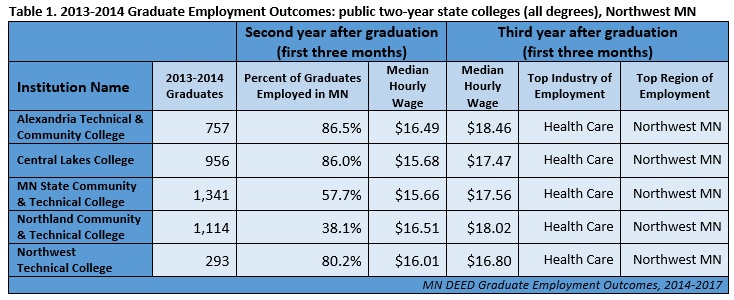 The presence of such industry powerhouses as Polaris, Arctic Cat and New Flyer make Northwest Minnesota a hub of transportation equipment manufacturing.
The presence of such industry powerhouses as Polaris, Arctic Cat and New Flyer make Northwest Minnesota a hub of transportation equipment manufacturing.
From wheat and potatoes to soybeans and sugar beets, the region is a major producer and processor of food staples and specialty agricultural products.
Want the freshest data delivered by email? Subscribe to our regional newsletters.
3/21/2018 12:04:56 PM
Chet Bodin
Following spring break, thousands of vocational and technical college students in Northwest Minnesota will be completing their degrees and re-entering the "real" world. Yet, many soon-to-be graduates are uncertain where they will end up. With DEED’s Graduate Employment Outcomes (GEO) gauging where their education will lead them is easier than it used to be. GEO data shows that, in the 2013-2014 school year, nearly 4,500 peers graduated from public two-year state colleges in Northwest Minnesota, and most are putting their post-secondary degrees and certificates to work.
In 2016, most of the graduates worked in Minnesota, including over 80 percent of those from three of the five schools examined below. Schools closer to North Dakota produced a lower percentage of in-state workers, but it’s likely many also found work just across the border. Data show that many of those who remain in Minnesota after graduation are earning livable wages, and sometimes more. The median wage of graduates from each regional institution exceeded $15.50 per hour two years later (Table 1). And most graduates are finding ample opportunity right here in Northwest Minnesota, which employed more of these graduates than major metro areas like St. Cloud, Duluth, and the Twin Cities.

Overall, 61 percent of Northwest graduates working in Minnesota were employed in the Northwest planning region (Figure 1), and good wages probably have a lot to do with it. Of graduates working regionally in 2016, the average median wage from the five public two-year state colleges was $16.49 an hour. This exceeded the overall median wage in Northwest Minnesota in 2016, and was $3.50 per hour more than the median wage offer in the fourth quarter that year. Graduates working elsewhere sometimes earned more, but didn’t always compare as favorably. For example, the median wage of graduates working in the Twin Cities was $18.85 per hour in 2016.
Graduates of public, two-year state colleges in Northwest Minnesota are also filling the workforce needs of the regional economy. The top industry of employment for graduates was health care and social assistance, which was not only the largest industry in Northwest Minnesota, it reported more regional job vacancies in 2016 than any other industry. In addition, by 2016 the median wage of graduates from institutions in the region was regularly much higher than the median wage offer of job vacancies in health care that year.

Such a high number of homegrown workers in Northwest Minnesota is a welcome development, but employers should not take them for granted. While Northwest Minnesota remains the top work location of public, two-year state college graduates in the region, other areas are upping their wages and developing programs to lure these workers away. In addition to the draw of the Twin Cities and North Dakota border cities, both the St. Cloud area and Duluth are making a push amid the tight labor market. Time will tell how successful they are, but regional employers may not want to wait to find out.
Contact Chet Bodin.